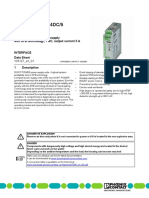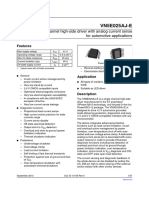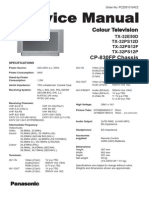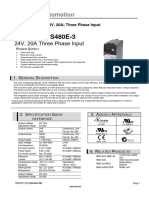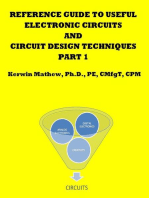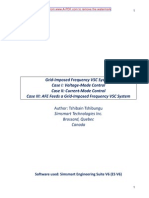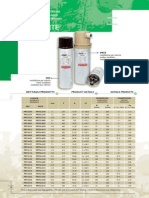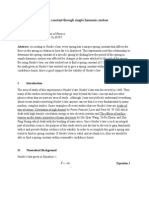Power Supply 24v
Power Supply 24v
Uploaded by
José Alberto Gomez JimenezCopyright:
Available Formats
Power Supply 24v
Power Supply 24v
Uploaded by
José Alberto Gomez JimenezCopyright
Available Formats
Share this document
Did you find this document useful?
Is this content inappropriate?
Copyright:
Available Formats
Power Supply 24v
Power Supply 24v
Uploaded by
José Alberto Gomez JimenezCopyright:
Available Formats
QUINT-PS/1AC/24DC/20
Power supply unit
Data sheet
103129_en_07 © PHOENIX CONTACT 2015-09-11
1 Description
QUINT POWER power supply units – Superior system avail- Features
ability with SFB technology
Compact power supply units of the new QUINT POWER Superior system availability
generation maximize the availability of your system. With – Using SFB technology (6 times the nominal current for
the SFB technology (Selective Fuse Breaking Technology), 12 ms), circuit breakers are tripped quickly and impor-
six times the nominal current for 12 ms, even the standard tant system parts remain in operation
power circuit-breakers can now also be triggered reliably
– Through the preventive monitoring of output voltage
and quickly. Faulty current paths are switched off selec-
and current and the transmission of critical operating
tively, the fault is located and important system parts con-
states to the controller
tinue to operate. Comprehensive diagnostics are provided
through constant monitoring of output voltage and current. – Through reliable starting of difficult loads with POWER
This preventive function monitoring visualizes critical oper- BOOST power reserve
ating modes and reports them to the control unit before an – Long mains buffering > 32 ms
error can occur. – High MTBF > 520,000 h (40°C)
Worldwide use
– Input voltage from 85 V AC ... 264 V AC
– Input voltage from 90 V DC ... 350 V DC
Flexible use
– Adjustable output voltage
– Can be used in Class I, Division 2, Groups A, B, C, D
(Hazardous Location) ANSI-ISA 12.12
Make sure you always use the latest documentation.
It can be downloaded from the product at phoenixcontact.net/products.
QUINT-PS/1AC/24DC/20
2 Table of contents
1 Description .............................................................................................................................. 1
2 Table of contents ..................................................................................................................... 2
3 Ordering data .......................................................................................................................... 3
4 Technical data ......................................................................................................................... 4
5 Safety regulations and installation notes.................................................................................. 8
6 Structure.................................................................................................................................. 9
6.1 Block diagram ..................................................................................................................... 9
6.2 Function elements ............................................................................................................... 9
6.3 Convection....................................................................................................................... 10
6.4 Mounting position .............................................................................................................. 11
7 Mounting/removal.................................................................................................................. 12
7.1 Normal mounting position .................................................................................................... 12
7.2 Mounting position rotated 90° ............................................................................................... 12
7.3 Mounting on a DIN rail ........................................................................................................ 12
7.4 Removal from the DIN rail .................................................................................................... 12
8 Device connection ................................................................................................................. 13
8.1 Network types ................................................................................................................... 13
8.2 AC input .......................................................................................................................... 13
8.3 DC output ........................................................................................................................ 14
9 SFB technology ..................................................................................................................... 14
9.1 Circuit breaker tripping characteristics .................................................................................... 14
9.2 Installation notes ............................................................................................................... 14
9.3 SFB configuration .............................................................................................................. 15
10 Signaling................................................................................................................................ 17
10.1 Floating switch contact ........................................................................................................ 17
10.2 Active signal outputs........................................................................................................... 17
10.3 Signal loop ....................................................................................................................... 18
11 Derating................................................................................................................................. 18
11.1 Temperature-dependent derating .......................................................................................... 18
12 Operating modes ................................................................................................................... 18
12.1 Series operation ................................................................................................................ 18
12.2 Parallel operation ............................................................................................................... 18
12.3 Redundant operation .......................................................................................................... 19
12.4 Increasing power ............................................................................................................... 19
103129_en_07 PHOENIX CONTACT 2
QUINT-PS/1AC/24DC/20
3 Ordering data
Description Type Order No. Pcs./Pkt.
Primary-switched QUINT POWER power supply for DIN rail mounting with QUINT-PS/1AC/24DC/20 2866776 1
SFB (Selective Fuse Breaking) Technology, input: 1-phase, output: 24 V
DC/20 A
Accessories Type Order No. Pcs./Pkt.
DIN rail diode module 12-24 V DC/2x20 A or 1x40 A. Uniform redundancy QUINT-DIODE/12-24DC/2X20/1X40 2320157 1
up to the consumer.
Active QUINT redundancy module for DIN rail mounting with ACB technol- QUINT-ORING/24DC/2X20/1X40 2320186 1
ogy (Active Current Balancing) and monitoring functions, input: 24 V DC,
output: 24 V DC/2 x 20 A or 1 x 40 A, including mounted universal DIN rail
adapter UTA 107/30
Filter for adherence to the EMC category EMC1 in shipbuilding for the ME-MAX-NEF/QUINT20A 2319919 1
QUINT-PS/1AC/24DC/20 power supply
Thermomagnetic device circuit breaker, 1-pos., tripping characteristic CB TM1 1A SFB P 2800836 1
SFB, 1 PDT contact, plug for base element.
Thermomagnetic device circuit breaker, 1-pos., tripping characteristic CB TM1 2A SFB P 2800837 1
SFB, 1 PDT contact, plug for base element.
Thermomagnetic device circuit breaker, 1-pos., tripping characteristic CB TM1 3A SFB P 2800838 1
SFB, 1 PDT contact, plug for base element.
Thermomagnetic device circuit breaker, 1-pos., tripping characteristic CB TM1 4A SFB P 2800839 1
SFB, 1 PDT contact, plug for base element.
Thermomagnetic device circuit breaker, 1-pos., tripping characteristic CB TM1 5A SFB P 2800840 1
SFB, 1 PDT contact, plug for base element.
Thermomagnetic device circuit breaker, 1-pos., tripping characteristic CB TM1 6A SFB P 2800841 1
SFB, 1 PDT contact, plug for base element.
Thermomagnetic device circuit breaker, 1-pos., tripping characteristic CB TM1 8A SFB P 2800842 1
SFB, 1 PDT contact, plug for base element.
Thermomagnetic device circuit breaker, 1-pos., tripping characteristic CB TM1 10A SFB P 2800843 1
SFB, 1 PDT contact, plug for base element.
Universal wall adapter UWA 182/52 2938235 1
Universal DIN rail adapter UTA 107 2853983 5
The fan for QUINT-PS/1AC and .../3AC can be mounted without the need QUINT-PS/FAN/4 2320076 1
for tools or other accessories. By using the fan, optimum cooling is ensured
at high ambient temperatures or if the mounting position is rotated.
Our range of accessories is being continually extended, our current range can be found in the download area.
103129_en_07 PHOENIX CONTACT 3
QUINT-PS/1AC/24DC/20
4 Technical data
Input data
Nominal input voltage 100 V AC ... 240 V AC
Input voltage range 85 V AC ... 264 V AC
Short-term input voltage 300 V AC
Input voltage range 90 V DC ... 350 V DC
AC frequency range 45 Hz ... 65 Hz
Frequency range DC 0 Hz
Current consumption 5.1 A (120 V AC)
2.3 A (230 V AC)
4.9 A (110 V DC)
2.4 A (220 V DC)
Inrush current limitation < 20 A (typical)
I2t < 3.2 A2s
Power failure bypass > 32 ms (120 V AC)
> 32 ms (230 V AC)
Typical response time < 0.6 s
Protective circuit Transient surge protection Varistor
Input fuse, integrated 12 A (slow-blow, internal)
Choice of suitable fuses 10 A ... 16 A (AC: Characteristics B, C, D, K)
Discharge current to PE < 3.5 mA
Output data
Nominal output voltage 24 V DC ±1 %
Setting range of the output voltage 18 V DC ... 29.5 V DC (> 24 V DC, constant capacity restricted)
Output current 20 A (-25°C ... 60°C, UOUT = 24 V DC)
26 A (with POWER BOOST, -25°C ... 40°C permanently, UOUT = 24 V DC)
120 A (SFB technology, 12 ms)
26 A (UIn ≥ 100 V AC)
Magnetic fuse tripping B2 / B4 / B6 / B10 / B16 / C2 / C4 / C6
Control deviation < 1 % (change in load, static 10 % ... 90 %)
< 2 % (change in load, dynamic 10 % ... 90 %)
< 0.1 % (change in input voltage ±10 %)
Efficiency > 93 % (for 230 V AC and nominal values)
Rise time < 0.1 s (UOUT (10 % ... 90 %))
Residual ripple < 30 mVPP (with nominal values)
Connection in parallel Yes, for redundancy and increased capacity
Connection in series Yes
Protection against surge voltage on the output < 35 V DC
Resistance to reverse feed max. 35 V DC
Power consumption
Maximum power dissipation NO-Load 8W
Power loss nominal load max. 40 W
DC OK active
Output description UOUT > 0.9 x UN: High signal
Voltage/current 18 V DC ... 24 V DC / ≤ 20 mA (short-circuit resistant)
Status display UOUT > 0.9 x UN: "DC OK" LED green / UOUT < 0.9 x UN: Flashing "DC OK" LED
103129_en_07 PHOENIX CONTACT 4
QUINT-PS/1AC/24DC/20
DC OK floating
Output description Relay contact, UOUT > 0.9 x UN: Contact closed
Voltage/current 30 V AC/DC / 0.5 A , 24 V DC / 1 A
Status display UOUT > 0.9 x UN: "DC OK" LED green / UOUT < 0.9 x UN: Flashing "DC OK" LED
POWER BOOST, active
Output description IOUT < IN: High signal
Voltage/current 18 V DC ... 24 V DC / ≤ 20 mA (short-circuit resistant)
Status display IOUT > IN: LED "BOOST" yellow
General data
Insulation voltage input/output 4 kV AC (type test)
2 kV AC (routine test)
Insulation voltage input / PE 3.5 kV AC (type test)
2 kV AC (routine test)
Insulation voltage output / PE 500 V DC (routine test)
Degree of protection IP20
Protection class I
MTBF (IEC 61709, SN 29500) > 520000 h (40°C) / > 900000 h (25 °C)
Side element version Aluminum
Hood version Galvanized sheet steel, free from chrome (VI)
Dimensions W / H / D (state of delivery) 90 mm / 130 mm / 125 mm
Dimensions W / H / D (90° turned) 122 mm / 130 mm / 93 mm
Weight 1.7 kg
Ambient conditions
Ambient temperature (operation) -25 °C ... 70 °C (> 60 °C Derating: 2,5 %/K)
Ambient temperature (start-up type tested) -40 °C
Ambient temperature (storage/transport) -40 °C ... 85 °C
Max. permissible relative humidity (operation) ≤ 95 % (at 25 °C, non-condensing)
Maximum altitude 6000 m
Vibration (operation) < 15 Hz, amplitude ±2.5 mm (according to IEC 60068-2-6)
15 Hz ... 150 Hz, 2.3g, 90 min.
Shock 30g in each direction, according to IEC 60068-2-27
Pollution degree in acc. with EN 60950-1 2
Climatic class 3K3 (in acc. with EN 60721)
Standards
Electrical Equipment for Machinery EN 60204-1
Electrical safety (of information technology equipment) IEC 60950-1/VDE 0805 (SELV)
Electronic equipment for use in electrical power installations EN 50178/VDE 0160 (PELV) / Overvoltage category III
SELV IEC 60950-1 (SELV) and EN 60204-1 (PELV)
Safe isolation DIN VDE 0100-410
Limitation of mains harmonic currents EN 61000-3-2
Network version/undervoltage SEMI F47-0706 Compliance Certificate
Medical standard IEC 60601-1, 2 x MOOP
Rail applications EN 50121-4
103129_en_07 PHOENIX CONTACT 5
QUINT-PS/1AC/24DC/20
Approvals
UL UL Listed UL 508
UL/C-UL Recognized UL 60950-1
UL ANSI/ISA-12.12.01 Class I, Division 2, Groups A, B, C, D (Hazardous Loca-
tion)
CSA CAN/CSA-C22.2 No. 60950-1-07
CSA-C22.2 No. 107.1-01
SIQ CB Scheme
Shipbuilding Germanischer Lloyd (EMC 1, only with upstream filter), ABS, LR, RINA, NK,
DNV, BV
BSH
Current approvals/permissions for the product can be found in the download area under phoenixcontact.net/products.
103129_en_07 PHOENIX CONTACT 6
QUINT-PS/1AC/24DC/20
Conformance with EMC Directive 2004/108/EC
Noise immunity according to EN 61000-6-2
EN 61000-6-2 requirement Tested
Electrostatic discharge EN 61000-4-2
Housing contact discharge 4 kV (Test intensity 2) 8 kV (Test intensity 4)
Housing air discharge 8 kV (Test intensity 3) 15 kV (Test intensity 4)
Comments Criterion B Criterion A
Electromagnetic HF field EN 61000-4-3
Frequency range 80 MHz ... 1 GHz 80 MHz ... 1 GHz
Test field strength 10 V/m (Test intensity 3) 20 V/m (Test intensity 3)
Frequency range 1.4 GHz ... 2 GHz 1 GHz ... 2 GHz
Test field strength 3 V/m (Test intensity 2) 10 V/m (Test intensity 3)
Frequency range 2 GHz ... 2.7 GHz 2 GHz ... 3 GHz
Test field strength 1 V/m (Test intensity 1) 10 V/m (Test intensity 3)
Comments Criterion A Criterion A
Fast transients (burst) EN 61000-4-4
Input 2 kV (Test intensity 3 - asymmetrical) 4 kV (Test intensity 4 - asymmetrical)
Output 2 kV (Test intensity 3 - asymmetrical) 2 kV (Test intensity 3 - asymmetrical)
Signal 1 kV (Test intensity 3 - asymmetrical) 2 kV (Test intensity 4 - asymmetrical)
Comments Criterion B Criterion A
Surge current loads (surge) EN 61000-4-5
Input 1 kV (Test intensity 2 - symmetrical) 2 kV (Test intensity 3 - symmetrical)
2 kV (Test intensity 3 - asymmetrical) 4 kV (Test intensity 4 - asymmetrical)
Output 0.5 kV (Test intensity 1 - symmetrical) 1 kV (Test intensity 2 - symmetrical)
0.5 kV (Test intensity 1 - asymmetrical) 2 kV (Test intensity 3 - asymmetrical)
Signal 1 kV (Test intensity 2 - asymmetrical) 1 kV (Test intensity 2 - asymmetrical)
Comments Criterion B Criterion A
Conducted interference EN 61000-4-6
Input/Output/Signal asymmetrical asymmetrical
Frequency range 0.15 MHz ... 80 MHz 0.15 MHz ... 80 MHz
Voltage 10 V (Test intensity 3) 10 V (Test intensity 3)
Comments Criterion A Criterion A
Key
Criterion A Normal operating behavior within the specified limits.
Criterion B Temporary impairment to operational behavior that is corrected by the device it-
self.
Emitted interference in acc. with EN 61000-6-3
Radio interference voltage in acc. with EN 55011 EN 55011 (EN 55022) Class B, area of application: Industry and residential
Emitted radio interference in acc. with EN 55011 EN 55011 (EN 55022) Class B, area of application: Industry and residential
All technical specifications are nominal values and refer to a room temperature of 25 °C and 70 % relative hu-
midity at 100 m above sea level.
103129_en_07 PHOENIX CONTACT 7
QUINT-PS/1AC/24DC/20
5 Safety regulations and installation
notes
EXPLOSION HAZARD!
Only remove equipment when it is discon-
nected and not in the potentially explosive
area.
DANGER
Components with dangerously high voltage
and high stored energy are located in the de-
vice!
Never carry out work on live parts!
Depending on the ambient temperature and
the load, the housing can become very hot!
CAUTION:
Before startup please ensure:
The connection must be carried out by a com-
petent person and protection against electric
shock guaranteed.
It must be possible to switch off power to de-
vice according to EN 60950.
All feed lines are sufficiently protected and di-
mensioned!
All output lines are dimensioned according to
the maximum output current of the device or
separately protected!
Sufficient convection must be guaranteed.
Observe mechanical and thermal limits.
CAUTION: Risk of injury
Cover termination area after installation in or-
der to avoid accidental contact with live parts
(e. g., installation in control cabinet).
NOTE: Danger if used improperly
The power supply units are built-in devices.
The device may only be installed and put into
operation by qualified personnel. The corre-
sponding national regulations must be ob-
served.
103129_en_07 PHOENIX CONTACT 8
QUINT-PS/1AC/24DC/20
6 Structure 6.2 Function elements
6.1 Block diagram
9
L (+)
active
N (-) PFC
DC OK 5
13 Sig
I < IN 14 nal
DC
OK
4 Ι<
ΙN
13
14 3
QUINT POWER
Bo
Element Meaning os
t
DC
OK
Rectification
18
Inp
ut
-29
AC ,5
L 10 V
0-2
N 40
V
Ou
tp
+ ut DC
Power factor correction filter + 24 V
- 20 8
active 1 -
A
PFC
-
7
2 6
Switch
Figure 1 Position of the function elements
Electrically isolated signal transmission No. Connection terminal blocks and function ele-
ments
Regulation 1 AC input
2 DC output
3 Active signal output I < IN (POWER BOOST)
Transformer 4 Active DC OK signal output
5 Floating DC OK switching output
Output filter 6 Potentiometer for setting the output voltage
7 DC OK signal LED, green
8 Signal LED boost, yellow
Floating switching output 9 Universal DIN rail adapter
103129_en_07 PHOENIX CONTACT 9
QUINT-PS/1AC/24DC/20
6.3 Convection
13 Sig
14 nal
DC
OK
Ι<
ΙN
QUINT POWER
Bo
os
t
DC
OK
18
Inp
ut
-29
AC ,5
L 10 V
0-2
N 40
V
Ou
tput
+ DC
+ 24
V
- 20
-
A
-
Figure 2 Convection
NOTE: enable convection
The housing can become very hot, depending
on the ambient temperature and module load.
To enable sufficient convection, we recom-
mend a minimum vertical clearance of 50 mm
from other modules. In order to ensure proper
functioning of the module, it is necessary to
maintain a lateral distance of 5 mm and
15 mm for active components.
The device can be snapped onto all DIN rails
in accordance with EN 60715 and should be
mounted in the normal mounting position
(connection terminal blocks on top and bot-
tom).
103129_en_07 PHOENIX CONTACT 10
QUINT-PS/1AC/24DC/20
6.4 Mounting position
5 90 5 122
50
115
130
230
Figure 3 Locked areas
Possible mounting positions:
Normal mounting position, installation depth 125 mm (+ DIN rail) (delivery state)
Mounting position rotated by 90°, installation depth of 93 mm (+ DIN rail)
103129_en_07 PHOENIX CONTACT 11
QUINT-PS/1AC/24DC/20
7 Mounting/removal 7.3 Mounting on a DIN rail
Position the module with the DIN rail guide on the upper
7.1 Normal mounting position edge of the DIN rail, and snap it in with a downward motion.
A B
13 Sig
14 nal
DC
OK
Ι<
ΙN
QUINT POWER
Bo
os
DC
t Figure 6 Assembly
OK
18
Inp
ut
-29
AC ,5
V
L
N
10
0-2
40V
7.4 Removal from the DIN rail
Ou
tput
+ DC
+ 24
-
V
20
-
A
Pull the snap lever open with the aid of a screwdriver and
-
slide the module out at the lower edge of the DIN rail.
Figure 4 Normal mounting position
7.2 Mounting position rotated 90°
For a mounting position rotated at 90° to the DIN rail, mount
the DIN rail adapter (UTA 107) as shown in the figure. No ad-
ditional assembly material is required. Mounting screws:
B
Torx® T10 (0.8 Nm ... 0.9 Nm tightening torque).
A
Figure 7 Removal
Figure 5 Mounting position rotated 90°
103129_en_07 PHOENIX CONTACT 12
QUINT-PS/1AC/24DC/20
8 Device connection 8.2 AC input
The supply voltage is connected via "Input AC 100 - 240 V"
8.1 Network types connection terminal blocks.
The device can be connected to 1-phase AC networks or to
two of the phase conductors of 3-phase systems (TN, TT or
IT system according to VDE 0100-300/IEC 60364-3) with
nominal voltages of 100 V AC ... 240 V AC.
For operation on two of the phase conductors
of a three-phase system, an isolating facility
for all poles must be provided.
13 Sig
14 nal
DC
OK
Ι<
TN-S TN-C ΙN
L L
QUINT POWER
N PEN
PE
Bo
os
t
DC
OK
18
Inp
ut
-29
,5
L N L N L
AC
N
10
0-2
40
V
+ − + − V
Ou
tp
+ ut DC
+ 24 V
- 20
-
A
L1 L1 -
L2 L2
L3 L3
N PEN
PE
8.2.1 Protection of the primary side
L N L N The device must be installed in acc. with the regulations as
+ − + −
in EN 60950. It must be possible to disconnect the device
using a suitable isolating facility outside the power supply.
TT iT Primary circuit mains protection, for example, is suitable for
L L
PEN N this purpose.
An internal fuse is provided for device protection. Additional
device protection is not required.
L N L N
+ − + − 8.2.2 Permissible backup fuse for mains protection
Power circuit-breaker 10 A or 16 A, characteristic B (or iden-
L1 L1
L2 L2 tical function).
L3 L3
N Connect a suitable fuse upstream for DC applications!
L N L N CAUTION:
+ − + −
If an internal fuse is triggered, there is a device
malfunction. In this case, the device must be
inspected in the factory.
103129_en_07 PHOENIX CONTACT 13
QUINT-PS/1AC/24DC/20
8.3 DC output 9 SFB technology
The output voltage is connected via the “Output DC” con-
SFB (Selective Fuse Breaking) technology reliably switches
nection terminal blocks.
off faulty current paths in the event of a short circuit. In this
case, it supplies up to six times the nominal current for 12
ms. SFB technology therefore reliably triggers standard cir-
cuit breakers. Faults are located reliably and important sys-
tem parts remain in operation.
9.1 Circuit breaker tripping characteristics
Typically, a circuit breaker trips within 3 ... 5 ms. Fast
enough to avoid voltage drops of parallel connected loads.
13 Sig
14 nal
DC
OK
Ι<
ΙN
I [A]
QUINT POWER
Bo
os 6x IN
DC
t
3-5 ms
OK
18
Inp -29
L
ut
AC
10
0-2
,5
V IBOOST
N 40
V
Ou
tp
+ ut DC
+ 24 V
- 20
-
A
-
IN
8.3.1 Protection of the secondary side Tripping time of the circuit breaker = 3 - 5 ms, typically
The device is electronically protected against short-circuit 9.2 Installation notes
and idling. In the event of a malfunction, the output voltage
is limited to 35 V DC. To use the SFB technology of the QUINT power supply, you
must observe the following requirements:
8.3.2 Output characteristic curve – When designing the secondary side, consider the con-
figuration matrix that describes the maximum cable
The module operates according to the U/I characteristic
lengths depending on the performance class of the de-
curve with POWER BOOST static power reserve. IBOOST is
vices, cable cross section, and the circuit breaker.
available with consistent output voltage UN. High switch-on
currents are therefore absorbed without voltage dips.
The current configuration matrix can be found
UOUT [V]
in the product download area.
I < IN I > IN
UN
– Ensure the lowest possible cable impedance at the in-
U < 0,9 x UN put of the power supply by using short cable lengths and
large cable cross sections.
IN IBOOST
Note the maximum distance between the
power supply and load.
IOUT [A]
(see also SFB configuration)
UN = 24 V
IN = 20 A
IBOOST = 26 A
SFB Technology = 120 A (12 ms)
PN = 480 W
PBOOST = 624 W
103129_en_07 PHOENIX CONTACT 14
QUINT-PS/1AC/24DC/20
9.3 SFB configuration
9.3.1 Standard circuit breakers
+ +
Power supply unit Load
- -
Figure 8 Cable lengths
Maximum distance between the power supply and load (l)
Cross section [2mm] 0.75 1.0 1.5 2.5 4.0 6.0
Distance l with C2 circuit breaker [m] 14 19 29 49 79 < 100
Distance l with C4 circuit breaker [m] 8 11 17 29 47 70
Distance l with C6 circuit breaker [m] 4 5 8 14 22 33
Distance l with B6 circuit breaker [m] 12 17 25 42 68 < 100
Distance l with B10 circuit breaker [m] 9 13 23 37 55
Distance l with B16 circuit breaker [m] 5 9 15 22
The following parameters are the basis for calculation:
– Circuit breaker from Siemens, B and C characteristics
(e. g., B6: 5SY6106-6)
– B characteristic: electromagnetic tripping of the circuit
breaker at the latest at (5-fold rated current) x (correc-
tion factor 1.2 at 0 Hz) = 6-fold rated current
– C characteristic: electromagnetic tripping of the circuit
breaker at the latest at (10-fold rated current) x (correc-
tion factor 1.2 at 0 Hz) = 12-fold rated current
– Ambient temperature: +20 °C
– The internal resistances of the circuit breakers are con-
sidered.
– In addition to short circuit current, the relevant power
supply unit supplies half of the nominal current for paths
connected in parallel.
103129_en_07 PHOENIX CONTACT 15
QUINT-PS/1AC/24DC/20
9.3.2 CB TM1 SFB device circuit breaker
+ +
Power supply unit Load
- -
Figure 9 Cable lengths
Maximum distance between the power supply and load (l)
Cross section [2mm] 0.75 1.0 1.5 2.5 4.0
Spacing with CB TM1 1A SFB P [m] 27 36 54 91 146
Spacing with CB TM1 2A SFB P [m] 18 25 37 63 101
Spacing with CB TM1 3A SFB P [m] 13 18 27 46 74
Spacing with CB TM1 4A SFB P [m] 10 14 21 35 57
Spacing with CB TM1 5A SFB P [m] 8 11 17 29 47
Spacing with CB TM1 6A SFB P [m] 6 8 12 20 32
Spacing with CB TM1 8A SFB P [m] 3 5 7 12 20
Spacing with CB TM1 10A SFB P [m] 3 4 8 13
The following parameters are the basis for calculation:
– CB TM1 xA SFB P device circuit breaker
– Electromagnetic triggering of the circuit breaker at the
latest at (10 times the rated current)
– Ambient temperature: +20 °C
– The internal resistance of the device circuit breakers is
taken into account
– In addition to short circuit current, the relevant power
supply unit supplies half of the nominal current for paths
connected in parallel.
103129_en_07 PHOENIX CONTACT 16
QUINT-PS/1AC/24DC/20
10 Signaling 10.1 Floating switch contact
The floating switch contact opens to indicate that the set out-
The following are available for function monitoring:
put voltage has been undershot by more than 10 % (UOUT <
– The active signal output DC OK 0.9 x UN). Signals and ohmic loads can be switched. For
– The floating DC OK output heavily inductive loads such as a relay, a suitable protective
– The active POWER BOOST signal output circuit (e.g., freewheeling diode) is necessary.
In addition, the “DC OK” and “BOOST” LEDs can be used to
evaluate the function of the power supply directly at the in-
stallation location (see output characteristic curve).
DC OK
30 V AC 0.5 A 13 14
24 V DC 1 A
+
PLC Digital Input
10.2 Active signal outputs
13 Sig
14 nal
DC
OK
For the transmission of signals to a higher-level controller,
Ι<
ΙN
the active “DC OK” and “Boost” signal outputs can be used.
The 18 ... 24 V DC signal is applied between the “DC OK”
QUINT POWER
Bo
and “-” (active DC OK signal output) or between “I < IN” and
os
t
DC
OK
“-” (active POWER BOOST signal output) and can withstand
Inp
18
-29
a maximum of 20 mA.
ut ,5
AC V
L 10
0-2
N 40
V By switching from “active high” to “low”, the DC OK signal
Ou
tp
+ ut DC output indicates that the set output voltage has been under-
+ 24 V
- 20
A
-
- shot by more than 10 % (UOUT < 0.9 x UN). The DC OK sig-
nal is decoupled from the power output. This makes it im-
possible for devices connected in parallel to act as an
Figure 10 Signal outputs external power supply.
The BOOST signal output “I < IN” indicates that the nominal
If the output voltage falls below 90% of the current has been exceeded. The power supply then
output voltage set on the potentiometer as a switches to POWER BOOST mode. Thanks to this preven-
result of overloading, the signal state “DC OK” tive function monitoring, critical operating states can be rec-
switches from “Active High” to “Low”. The limit ognized at an early stage, prior to a voltage dip occurring.
value of 90% always refers to the set output
voltage range of 18 V DC to 29.5 V DC.
DC OK
13 14
Normal opera- POWER BOOST Overload mode
tion I < IN I > IN UOUT < 0.9 x UN
“DC OK” LED, lit lit Flashing 18 ... 24 V DC / 20 mA
green
“BOOST” LED, OFF lit lit
yellow + +
“DC OK” signal ON ON OFF PLC Digital Input
“DC OK” relay closed closed opened
Signal “I < IN” ON OFF OFF
Meaning Normal operation POWER BOOST Overload mode,
of the power sup- mode, e.g., for e. g., load short
ply unit (UOUT > starting loads circuit or over-
21.5 V) load
103129_en_07 PHOENIX CONTACT 17
QUINT-PS/1AC/24DC/20
10.3 Signal loop 12 Operating modes
Monitoring of two devices: use the active DC OK signal out-
put of device 1 and loop the floating alarm output of device 12.1 Series operation
2. In the event of a malfunction, you will receive a group error Two power supplies can be connected in series to double
message. Any number of devices can be looped. This signal the voltage. Only devices of the same performance class
combination saves wiring costs and logic inputs. should be connected in series. Series connection should al-
ways be used when the output voltage of the module is not
sufficient. For example, power supplies with 24 V DC nomi-
nal output voltage each supply 48 V DC in series. Depend-
DC OK
DC OK
13 14 13 14
ing on the specification of the PE connection, output volt-
ages of +48 V or -48 V as well as ±24 V DC can also be
+ made available.
30 V AC 0.5 A + + +
24 V DC 1 A
+
PLC Digital Input - - -
+24 V
+48 V -48 V
11 Derating
+ + -24 V +
11.1 Temperature-dependent derating
- - -
At an ambient temperature of -25 °C to +40 °C, the device
continuously supplies the IBOOST output current. The device
can supply the IN nominal output current up to an ambient Figure 11 Series operation
temperature of +60°C. At ambient temperatures above +60
°C, the output power must be decreased by 2.5 % per Kelvin 12.2 Parallel operation
increase in temperature. At ambient temperatures above Devices of the same type can be connected in parallel to in-
+70 °C or in the event of a thermal overload, the device does crease both redundancy and power. No further adjustments
not switch off. The output power is decreased to such an ex- are necessary for the default setting.
tent that device protection is provided. Once the device has
If the output voltage of a power supply unit is adjusted, all
cooled down, the output power is increased again.
power supplies connected in parallel must be set to the
same output voltage in order to ensure an even distribution
Output current [A]
IBOOST of current.
In order to ensure symmetrical current distribution, we rec-
IN ommend that all cable connections from the power supply
unit to the busbar are the same length and have the same
cross section.
Depending on the system, a protective circuit should be in-
stalled at each individual device output (e.g., decoupling di-
0 ode, DC fuse or circuit breaker) for parallel connection of
-25 20 40 60 more than two power supplies. This prevents high return
Ambient temperature [°C]
currents in the event of a secondary device fault.
IN IN
+ − + −
+
−
Σ = IN
+ −
103129_en_07 PHOENIX CONTACT 18
QUINT-PS/1AC/24DC/20
12.3 Redundant operation 12.4 Increasing power
Redundant circuits are suitable for supplying systems, The output current can be increased to n x IN in the case of
which place particularly high demands on operational n parallel connected devices. Parallel connection for in-
safety. If a fault occurs in the primary circuit of the first power creasing power is used when extending existing systems. A
supply unit, the second device automatically takes over the parallel connection is recommended if the power supply unit
complete power supply without interruption, and vice versa. does not cover the current consumption of the most power-
For this purpose, the power supply units to be connected in ful load. Otherwise, the load should be distributed between
parallel must be large enough to ensure that the total current individual devices that are independent from one another.
requirements of all loads can be fully met by one power sup-
ply unit. External decoupling diodes are required for 100% IN IN
redundancy! + − + −
Optimization of redundancy can be achieved by decoupling
and monitoring. Phoenix Contact offers a comprehensive
+
product range for this purpose (e. g., QUINT-DIODE or
−
QUINT-ORING).
Example: diode module
Σ = 2 x IN
+ −
IN IN
+ − + −
+
−
Σ = IN
+ −
Example: QUINT ORING
IN IN
+ − + −
+
−
Σ = IN
+ −
103129_en_07 PHOENIX CONTACT GmbH & Co. KG • 32823 Blomberg • Germany 19
phoenixcontact.com
You might also like
- MDCAT-Physics - Key Points PDFDocument15 pagesMDCAT-Physics - Key Points PDFFarhad Ali50% (2)
- DB en Quint Ps 1ac 24dc 5 103127 en 06Document19 pagesDB en Quint Ps 1ac 24dc 5 103127 en 06sandesh sawateNo ratings yet
- DB en Quint Ps 24dc 24dc 20 104791 en 03Document23 pagesDB en Quint Ps 24dc 24dc 20 104791 en 03aliNo ratings yet
- QUINT4-PS/1AC/24DC/20/+: Power Supply UnitDocument51 pagesQUINT4-PS/1AC/24DC/20/+: Power Supply UniteamazomNo ratings yet
- DB - en - Quint4 - Ps - 1ac - 24dc - 20 - 107101 - en - 01 1Document50 pagesDB - en - Quint4 - Ps - 1ac - 24dc - 20 - 107101 - en - 01 1Razvan PatruNo ratings yet
- DB en Quint4 Ps 1ac 24dc 10 107100 en 02Document51 pagesDB en Quint4 Ps 1ac 24dc 10 107100 en 02Ahsan Naseer Naseer AhmadNo ratings yet
- DB en Trio Ps 2g 3ac 24dc 40 105907 en 01Document25 pagesDB en Trio Ps 2g 3ac 24dc 40 105907 en 01ray griffitNo ratings yet
- QUINT4-PS/1AC/24DC/40: Power Supply UnitDocument52 pagesQUINT4-PS/1AC/24DC/40: Power Supply UnitMA1357No ratings yet
- QUINT-PS/1AC/24DC/5: Primary-Switched Power Supply With SFB Technology, 1 AC, Output Current 5 ADocument14 pagesQUINT-PS/1AC/24DC/5: Primary-Switched Power Supply With SFB Technology, 1 AC, Output Current 5 AVladimirNo ratings yet
- Quint - PS - 100 - 240ac24 DC40Document15 pagesQuint - PS - 100 - 240ac24 DC40AndyNo ratings yet
- DB en Trio Ps 2g 1ac 24dc 5 105900 en 01Document20 pagesDB en Trio Ps 2g 1ac 24dc 5 105900 en 01Dimas Maulana Ahmadi AriefNo ratings yet
- Quint-Ps 1ac24dc40 PDFDocument15 pagesQuint-Ps 1ac24dc40 PDFAndy Kong KingNo ratings yet
- TXS0102 2-Bit Bidirectional Voltage-Level Translator For Open-Drain and Push-Pull ApplicationsDocument47 pagesTXS0102 2-Bit Bidirectional Voltage-Level Translator For Open-Drain and Push-Pull Applicationskarthik4096No ratings yet
- DB en Quint4 Ps 24dc 24dc 10 PT 108863 en 02Document50 pagesDB en Quint4 Ps 24dc 24dc 10 PT 108863 en 02Vegard SømliøyNo ratings yet
- DB en Quint4 Ps 3ac 24dc 10 107104 en 01Document51 pagesDB en Quint4 Ps 3ac 24dc 10 107104 en 01olivier90dirNo ratings yet
- Vn5016aj eDocument32 pagesVn5016aj eforeman pemudaNo ratings yet
- VNQ 7140 AjDocument46 pagesVNQ 7140 AjJason van KolfschotenNo ratings yet
- VN5T016AH-E: Single Channel High-Side Driver With Analog Current Sense For 24 V Automotive ApplicationsDocument31 pagesVN5T016AH-E: Single Channel High-Side Driver With Analog Current Sense For 24 V Automotive ApplicationscutoNo ratings yet
- QUINT4-UPS/1AC/1AC/500VA/USB: Uninterruptible Power SupplyDocument35 pagesQUINT4-UPS/1AC/1AC/500VA/USB: Uninterruptible Power SupplyOmar Alfredo Del Castillo QuispeNo ratings yet
- QUINT4-PS/1AC/24DC/5: Power Supply UnitDocument50 pagesQUINT4-PS/1AC/24DC/5: Power Supply UnitOmar Alfredo Del Castillo QuispeNo ratings yet
- Quint4 UpsDocument84 pagesQuint4 UpsUlaş DoğruNo ratings yet
- Vn5025aj E-1852654Document32 pagesVn5025aj E-1852654Ehsan AsgariNo ratings yet
- DB en Quint4 Ups 24dc 24dc 20 Usb PN Eip Ec 107553 en 00aDocument81 pagesDB en Quint4 Ups 24dc 24dc 20 Usb PN Eip Ec 107553 en 00aGiau Ngoc HoangNo ratings yet
- DB en Quint4 Ups 24dc 24dc 40 Usb PN Eip Ec 107558 en 00a PDFDocument81 pagesDB en Quint4 Ups 24dc 24dc 40 Usb PN Eip Ec 107558 en 00a PDFTomás PedrosaNo ratings yet
- Hall Sensor DRV5053Document30 pagesHall Sensor DRV5053jpNo ratings yet
- QUINT4-PS-1AC-24DC-20 - 2904617 SIL3 Safety ManualDocument7 pagesQUINT4-PS-1AC-24DC-20 - 2904617 SIL3 Safety ManualdiveshNo ratings yet
- VNQ5E050AK-E: Quad Channel High-Side Driver With Analog Current Sense For Automotive ApplicationsDocument37 pagesVNQ5E050AK-E: Quad Channel High-Side Driver With Analog Current Sense For Automotive ApplicationsTom TomNo ratings yet
- NV6128 Datasheet-3076917Document26 pagesNV6128 Datasheet-3076917mNo ratings yet
- DB en Quint4 Ps 1ac 110dc 4 109530 en 00Document48 pagesDB en Quint4 Ps 1ac 110dc 4 109530 en 00Asad NaeemNo ratings yet
- DB en Trio Ups 2g 1ac 24dc 5 107431 en 02Document30 pagesDB en Trio Ups 2g 1ac 24dc 5 107431 en 02spurscoukNo ratings yet
- VND 7030 AjDocument46 pagesVND 7030 AjMahdi KhaksarNo ratings yet
- Vnd5e160aj PDFDocument37 pagesVnd5e160aj PDFtsdcnNo ratings yet
- 1606-sr005 - En-E 1606-XLS80EDocument21 pages1606-sr005 - En-E 1606-XLS80EOrion ValgroundNo ratings yet
- HART Transparent Repeater: ApplicationDocument2 pagesHART Transparent Repeater: ApplicationEzz Civ EngNo ratings yet
- Solenoid / Alarm Driver: Advanced FeaturesDocument2 pagesSolenoid / Alarm Driver: Advanced FeaturesMark MassaNo ratings yet
- SKPP e DS Ups 2021 01Document11 pagesSKPP e DS Ups 2021 01d41109289No ratings yet
- Vn5e025aj eDocument37 pagesVn5e025aj eMohammad TanhaNo ratings yet
- Brilliance Air 6-10-16 Manual 3Document27 pagesBrilliance Air 6-10-16 Manual 3Karthick BalakrishnanNo ratings yet
- Single Phase Recloser CatalogDocument8 pagesSingle Phase Recloser CatalogCesar VenturoNo ratings yet
- Daewoo CP 830FPDocument23 pagesDaewoo CP 830FPBaciu CatalinNo ratings yet
- Phoenix 2320186 Spec SheetDocument15 pagesPhoenix 2320186 Spec SheetabcdNo ratings yet
- POWER SUPPLY 48V DC DB - en - Trio - Ps - 2g - 1ac - 48dc - 10 - 107009 - en - 00Document25 pagesPOWER SUPPLY 48V DC DB - en - Trio - Ps - 2g - 1ac - 48dc - 10 - 107009 - en - 00Mahmoud AlswisyNo ratings yet
- Ex Repeater / Power SupplyDocument2 pagesEx Repeater / Power SupplyNikul PanchalNo ratings yet
- QUINT4-UPS/1AC/1AC/1KVA: Uninterruptible Power SupplyDocument33 pagesQUINT4-UPS/1AC/1AC/1KVA: Uninterruptible Power SupplyOmar Alfredo Del Castillo QuispeNo ratings yet
- Ip SelctionDocument22 pagesIp SelctionHATEM68No ratings yet
- db_en_trio_ups_2g_1ac_24dc_5_107431_en_03 (1)Document30 pagesdb_en_trio_ups_2g_1ac_24dc_5_107431_en_03 (1)Davis DimantsNo ratings yet
- Vnd5e025ay eDocument37 pagesVnd5e025ay ePedro Henrique SilvaNo ratings yet
- BTS50080-1TMB: Smart High-Side Power Switch Profet One ChannelDocument27 pagesBTS50080-1TMB: Smart High-Side Power Switch Profet One Channelbünyamin altunNo ratings yet
- Tca 9406Document38 pagesTca 9406Michael RandrianantenainaNo ratings yet
- PANASONIC TX-21AT2P (CP-521P) (WWW - Pieseelectronice.net)Document17 pagesPANASONIC TX-21AT2P (CP-521P) (WWW - Pieseelectronice.net)tipudelacablutvNo ratings yet
- Color Television: Service ManualDocument65 pagesColor Television: Service ManualMike WardNo ratings yet
- 550114b (H1DN-ing)Document35 pages550114b (H1DN-ing)Vladimir KrivenokNo ratings yet
- QUINT-PS/ 1AC/24DC/20: Primary-Switched Power Supply With SFB Technology, 1 AC, Output Current 20 ADocument15 pagesQUINT-PS/ 1AC/24DC/20: Primary-Switched Power Supply With SFB Technology, 1 AC, Output Current 20 Acontenidos78No ratings yet
- 1606-XLS480E-3: RockwellDocument24 pages1606-XLS480E-3: RockwellOrion ValgroundNo ratings yet
- Vnd5e160j eDocument34 pagesVnd5e160j erwidyanartoNo ratings yet
- Vnq5027ak eDocument31 pagesVnq5027ak edaniel_matias_2No ratings yet
- Color Television: Service ManualDocument59 pagesColor Television: Service Manuala1electronicsNo ratings yet
- L - P, S D - C D I: OW Ower Ingle AND UAL Hannel Igital SolatorsDocument37 pagesL - P, S D - C D I: OW Ower Ingle AND UAL Hannel Igital SolatorshmopjmzdzvaluidrkyNo ratings yet
- Reference Guide To Useful Electronic Circuits And Circuit Design Techniques - Part 2From EverandReference Guide To Useful Electronic Circuits And Circuit Design Techniques - Part 2No ratings yet
- Reference Guide To Useful Electronic Circuits And Circuit Design Techniques - Part 1From EverandReference Guide To Useful Electronic Circuits And Circuit Design Techniques - Part 1Rating: 2.5 out of 5 stars2.5/5 (3)
- IPS-ENERGY - Available Relay ModelsDocument597 pagesIPS-ENERGY - Available Relay Modelsbrahim100% (2)
- Fluid MechanicsDocument40 pagesFluid MechanicsShahinur AlamNo ratings yet
- Codigo Ansi de Funciones de ProteccionesDocument5 pagesCodigo Ansi de Funciones de ProteccionesGerman SchwabNo ratings yet
- Taller 2Document2 pagesTaller 2marcela galindoNo ratings yet
- Some Examples. Constraints and Lagrange MultipliersDocument15 pagesSome Examples. Constraints and Lagrange MultipliersGuillermoEatonNo ratings yet
- Temperature Analysis in A Ball Bearing Under Heat Generation Caused by FrictionDocument11 pagesTemperature Analysis in A Ball Bearing Under Heat Generation Caused by Frictionlegy86No ratings yet
- 120 Days CountdownDocument6 pages120 Days CountdownApuNo ratings yet
- Design and Fabrication of 3-Phase Ac Voltage Controller Fed Speed Control of 3-Phase Sqim L. Joseph Anil Kumar B. Krishna ChaitanyaDocument5 pagesDesign and Fabrication of 3-Phase Ac Voltage Controller Fed Speed Control of 3-Phase Sqim L. Joseph Anil Kumar B. Krishna ChaitanyaSahabat SimatupangNo ratings yet
- Grid Imposed Frequency VSC SystemDocument27 pagesGrid Imposed Frequency VSC SystemTshibain TshibunguNo ratings yet
- C2-Free Vib SDOFDocument14 pagesC2-Free Vib SDOFYogen RajNo ratings yet
- LT Panels - BoqDocument4 pagesLT Panels - BoqlanikhilNo ratings yet
- Engineering MechanicsDocument2 pagesEngineering MechanicsfotickNo ratings yet
- NBPhO18 SolDocument5 pagesNBPhO18 SolTest EmailNo ratings yet
- Mini Hi-Fi System: Service ManualDocument58 pagesMini Hi-Fi System: Service ManualJuanCarlosCaballero100% (1)
- Test 4 Review SolutionsDocument13 pagesTest 4 Review SolutionsFabio Suta ArandiaNo ratings yet
- Final V2G and G2V REPORT PRESENTATIONDocument10 pagesFinal V2G and G2V REPORT PRESENTATIONsuman shah100% (1)
- Tyco Rele Ec v23078 c1002 A303 DatasheetDocument5 pagesTyco Rele Ec v23078 c1002 A303 DatasheetCristianoNo ratings yet
- 4.5 Modeling of Transmission Lines: Figure 4-9Document17 pages4.5 Modeling of Transmission Lines: Figure 4-9shashm024No ratings yet
- Easun MIT114Document32 pagesEasun MIT114chandraprakashhh0% (1)
- Dynamic ElectricityDocument61 pagesDynamic ElectricityRiandi Kartiko100% (1)
- 8.IJAEST Vol No 10 Issue No 1 Simulation and Modeling of Hydro Power Plant To Study Time Response During Different Gate States 042 047Document6 pages8.IJAEST Vol No 10 Issue No 1 Simulation and Modeling of Hydro Power Plant To Study Time Response During Different Gate States 042 047Raveendhra Iitr100% (1)
- Anatomy of An Electromagnetic Wave - Science Mission DirectorateDocument8 pagesAnatomy of An Electromagnetic Wave - Science Mission DirectorateBhaskarKhersaNo ratings yet
- History of ElectricityDocument2 pagesHistory of ElectricitySidra Khalid100% (1)
- Worked Place: Nepal Electricity Authority Janakpur, DhanushaDocument3 pagesWorked Place: Nepal Electricity Authority Janakpur, DhanushaDipesh YadavNo ratings yet
- Handout 4 v3 PDFDocument10 pagesHandout 4 v3 PDFMayank SoniNo ratings yet
- Enerlux Capacitor and ReactorDocument8 pagesEnerlux Capacitor and ReactorUrsula JohnsonNo ratings yet
- Network Analysis - ETAPDocument16 pagesNetwork Analysis - ETAPJoeDabid100% (1)
- PIEAS M.S 2014 QuestionsDocument11 pagesPIEAS M.S 2014 QuestionsZohaib Alam Warraich100% (1)
- Hooke's Law LabDocument5 pagesHooke's Law LabTrevor LeachNo ratings yet








